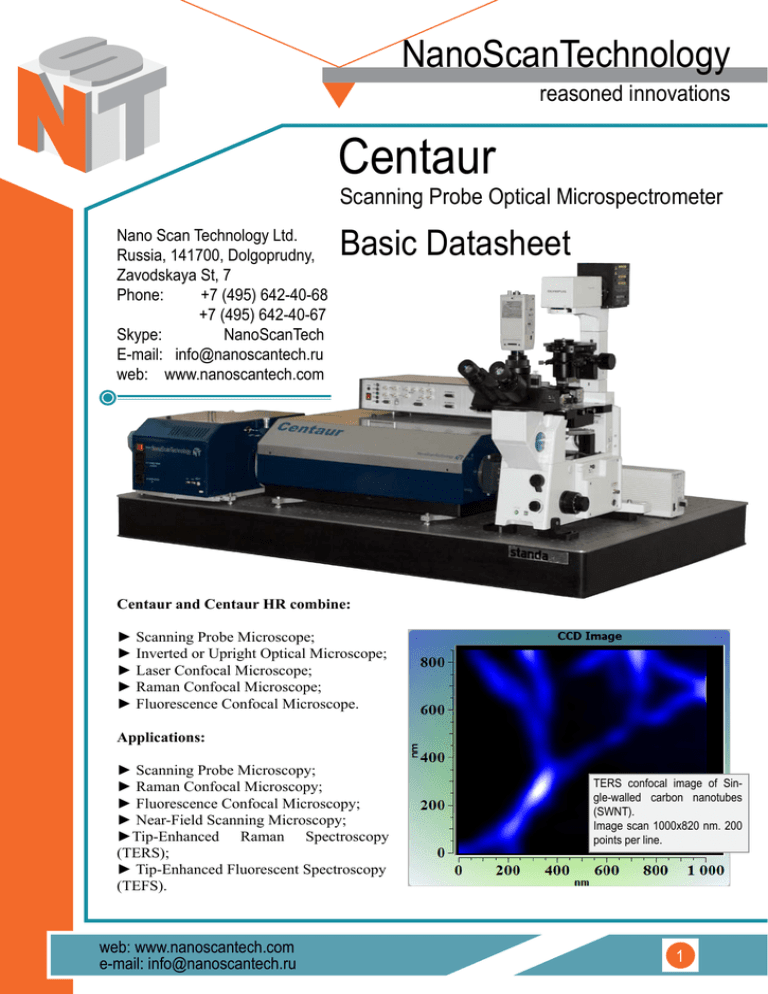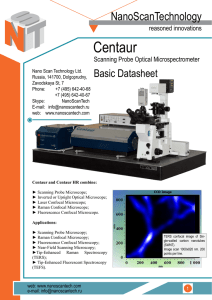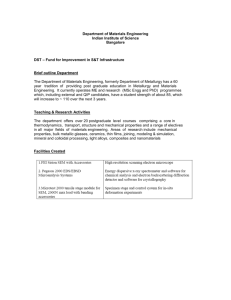Centaur Certus Optic NanoScanTechnology
advertisement

NanoScanTechnology reasoned innovations Centaur Certus Optic Scanning Probe Optical Microspectrometer Scanning Probe Microscope + Optical Microscope Nano Scan Technology Ltd. Russia, 141700, Dolgoprudny, Zavodskaya St, 7 Phone: +7 (495) 642-40-68 +7 (495) 642-40-67 Skype: NanoScanTech E-mail: info@nanoscantech.ru web: www.nanoscantech.com Basic Datasheet Centaur and Centaur HR combine: ► Scanning Probe Microscope; ► Inverted or Upright Optical Microscope; ► Laser Confocal Microscope; ► Raman Confocal Microscope; ► Fluorescence Confocal Microscope. Applications: ► Scanning Probe Microscopy; ► Raman Confocal Microscopy; ► Fluorescence Confocal Microscopy; ► Near-Field Scanning Microscopy; ►Tip-Enhanced Raman Spectroscopy (TERS); ► Tip-Enhanced Fluorescent Spectroscopy (TEFS). web: www.nanoscantech.com e-mail: info@nanoscantech.ru TERS confocal image of Single-walled carbon nanotubes (SWNT). Image scan 1000x820 nm. 200 points per line. 1 Where to use: ► Chemistry. Combination of methods of scanning probe microscopy and Raman spectroscopy allows the analysis of the composition and structure of organic and inorganic substances, traditional and composite materials; ► Physics. Investigation of physical characteristics of surface and subsurface layers of substances and materials; ► Biology. Study of tissues, cells and their structures, biological molecules and the interactions between them; ► Interdisciplinary research. Research in the field of nanotechnology, pharmaceuticals, materials science, mineralogy, geology, forensic, analysis of art and many others. Advantages of Centaur: ► Dual independent scanners (in head and base); ► Multiple simultaneous signal recording (confocal, spectra, topography, phase etc.); ► Full spectra recording in each scan point; ► Integration with virtually unmodified upright or inverted optical microscopes to work with transparent and none transparent samples; ► Modern cross-platform software (for all the Centaur units). Centaur - layout: Collimator Preliminary Monochromator Beam Expander Confocal PMT Optical fiber XY Scanning Stage SPM Head Laser APD OPTOMECHANICAL UNIT Sample Reference PMT CCD CHERNY-TURNER MONOCHROMATOR OPTICAL MICROSCOPE Input laser beam “Cleaned” laser beam Secondary emmision (Fluorescence, Raman) 2 Variable neutral density filter Beam splitter Variable pinhole/slit Edge filters Lens Spherical mirror Prizm Diffraction grating web: www.nanoscantech.com e-mail: info@nanoscantech.ru 1 Main parameters 1.1 SPM resolution (XY lateral) <1 nm 1.2 SPM resolution (Z vertical) <0.1 nm 1.3 Field of view of SPM (scanning range) when scanning with probe 100х100 μm 1.4 Field of view of SPM (scanning range) when scanning with sample 100x100 μm 1.5 Z range 15 μm 1.6 Residual nonlinearity of the scanner <0.3% 1.7 Optical resolution in the a confocal microscope mode ~2/3 λ 1.8 Field of view (scanning range) in confocal mode 100x100 μm Spectral resolution: 1.9 Grating 200 lines/mm 1.45 nm Grating 600 lines/mm 0.45 nm Grating 1200 lines/mm 0.22 nm Spectral range: 1.10 Grating 200 lines/mm 330 - 1300 nm Grating 600 lines/mm 400 - 1200 nm Grating 1200 lines/mm 400 - 870 nm 1.11 Optical transmission within the spectral range ≥ 60% 1.12 Signal-to-noise ratio at the peak of the luminescence spectra (for the luminescence signal of the dye with a quantum yield of not less than 50% at a concentration of 10-5 mol/liter and the shift of the maximum of the luminescence line relative to the maximum excitation lines not less than 5 nm). ≥100 1.13 Signal-to-noise ratio at the peak of the Raman spectra (for the Raman signal from the oscillator strength of the benzene molecule at a frequency of 607 cm-1 and the frequency shift of not less than 200 cm-1) ≥100000 2 2.1 Scanning Probe Microscope unit SPM head 2.1.1 Built-in flat XYZ scanner 2.1.1.1 Scanning/positioning XYZ range 100x100x15 μm 2.1.1.2 XY stage resonant frequency 1 кHz 2.1.1.3 Z rezonant frequency 7 кHz 2.1.1.4 Residual nonlinearity <0.3% 2.1.1.5 SPM resolution (XY lateral) <1 nm 2.1.1.6 SPM resolution (Z vertical) <0.1 nm 2.1.2 Displacement sensors 2.1.2.1 Sensors type 2.1.2.2 Measuring principle 2.1.3 Time-to-digital convertion Scanning head approach system 2.1.3.1 Minimal step 2.1.3.2 Coarse approach implementation 2.1.3.3 Number of stepper motors 2.2 Capacitance 1 μm Stepper motors 3 Scanning stage 2.2.1 Built-in flat XY scanner (XY stage) 2.2.1.1 Dynamic range scanning / positioning XY 100x100 μm 2.2.1.2 Resonant frequencies of XY 1 kHz 2.2.1.3 Residual nonlinearity ≤0.3%. 2.2.2 Sensors 2.2.2.1 Sensors type web: www.nanoscantech.com e-mail: info@nanoscantech.ru Capacitance sensor 3 3 3.1 Optical unit Pre-monochromator to filter spurious modes of laser source 3.1.1 Spectral range 3.1.2 Spectral resolution < 1 nm 3.1.3 Variable pinhole diameter range 0..1 mm 3.2 400..800 nm Motorized ND filter to adjust the power of the input laser 3.2.1 ND filter range 0..4 3.2.2 Number of gradations 256 3.3 Expander / collimator beam unit 3.3.1 Diameter of the input beam 3.3.2 Output beam diameter 3.4 1 mm 3..15 mm Signal PMT unit 3.4.1 Positioning Three coordinate motorized objective 3.4.2 Focal plane At the intersection of the slit 3.4.3 Resolution of laser confocal images 3.4.4 PMT control 3.5 3.5.1 3.6 ~2/3 λ Software Reference photomultiplier unit Input laser intensity calibration PMT and software Confocal laser line selection unit 3.6.1 Filter type 3.6.2 Half-width of the recession curve of the transmission filters 3.6.3 Angle of incidence on the filters 3.6.4 Ability to measure the line of the secondary spectrum 3.7 Objective 3.8 Monochromator unit Edge filters 3 nm 5-16° to 80 cm from the line excitation -1 Three-axis motorized focusing objective 3.8.1 Focal length 3.8.2 Spectral range 3.8.3 Grating 1 1:1 (mirror) 3.8.4 Grating 2 200 lines/mm (blaze 500 nm) 3.8.5 Grating 3 600 lines/mm (blaze 600 nm) 3.8.6 Grating 4 1200 lines/mm (blaze 600 nm) 3.8.7 Crossed entrance slit range 3.8.8 Entrance slit accuracy 1 μm 3.8.9 Output slit range 1 mm 3.8.10 Accuracy of the output slit 1 μm 3.8.11 Slits, mirrors, shutters and gratings mechanic 3.8.12 Interface 3.9 3.9.1 3.10 F=260 mm 200-1000 nm 1x1 mm All-around automation USB 2.0 Periscope unit Integration with upright or inverted microscope Implemented CCD (basic) 3.10.1 Cooling 3.10.2 Minimum temperature cooling 3.10.3 Dark current 3.10.4 Quantum yield 95% over the entire spectral range 3.10.5 Spectral range 400-1000 nm 3.10.6 Number of pixels 1024х256 Interface USB 2.0 3.10.7 3.11 Buid-in Peltier element -30°C 1 count/sec per pixel Excitation laser source (basic) 3.11.1 Wavelength 3.11.2 Output power 4 473 nm 25, 50 mW web: www.nanoscantech.com e-mail: info@nanoscantech.ru 3.11.3 Spectral linewidth 3.11.4 Spatial mode <1 MHz (<0.01 pm) TEM00 M2 <1.1 3.11.5 Beam diameter at aperture 3.11.6 Beam divergence (full angle) <1.2 mrad 3.11.7 Noise, 20 Hz -20 MHz (pk-pk) <2%, typical <1.5% 3.11.8 Noise, 20 Hz -20 MHz (rms) 3.11.9 Long-term stability (8 hr) 3.11.10 Beam pointing stability (over 10-40 °C) 3.11.11 Polarization ratio 3.11.12 Total system power consumption 3.11.13 Operating temperature 3.12 700 μm <0.25%, typical <0.15% <2% (±3°C) <10 μrad/°C, typical 5 μrad/°C >100:1 linear <25 W, typical <15 W 10-40°C Vibration protection 3.12.1 Type of vibration protection 3.12.2 Implementation of the system of vibration protection 3.12.3 Dimensions of the optical plate, WxDxH 3.12.4 Thread diameter 3.12.5 Cells step 4 Passive Optical plate 900х1800х200 mm М6 25 mm Optical microscope 4.1 Type, manufacturer and specifications of the microscope 4.2 Inverted microscope (for trasperent samles) Optionally, in accordance with the terms of the specification either upright or inverted microscope 4.2.1 Brand of microscope Olympus IX71 4.2.2 Type of microscope Inverted 4.2.3 Transmitted light illuminator 4.2.3.1 Illuminator The illuminator of the transmitted light 4.2.3.2 Lamp Halogen, 12 V, 100 W 4.2.3.3 Power 4.2.4 Focus 4.2.4.1 Stroke 9 mm 4.2.4.2 Minimum fine focus graduation 1 μm 4.2.5 Condenser 4.2.5.1 Type Universal 4.2.5.2 N.A. 0.55 4.2.5.3 W.D. 23.3 mm 4.2.6 4.2.7 4.3 Built-in magnification changer 1х / 1,6х Light path selection 2-step Upright microscope (for opaque samples) 4.3.1 Brand of microscope Nikon Eclipse FN1 4.3.2 Type of microscope Upright 4.3.3 Light illuminator 4.3.3.1 Illuminator Lamp unit FN-LH with pre-centering 4.3.3.2 Lamp Halogen, 12 V, 100 W 4.3.4 Focus 4.3.4.1 Stroke 9 mm 4.3.4.2 Minimum fine focus graduation 1 μm 4.3.5 High eyepoint 4.2.6 Condenser 10x, F.N.: 22, 25 4.2.6.1 Type Universal, revolving type 4.2.6.2 N.A. 0.78 4.2.6.3 W.D. 13 mm web: www.nanoscantech.com e-mail: info@nanoscantech.ru 5 EG-3000 SPM drive digital controller ►Electronic controller EG-3000 is designed to control SPM or scanning confocal microscope. Controller provides data acquisition from internal sensors and external devices, applies control voltage to scanners piezoelectric actuators. All obtained information is transferring to PC workstation for visualization and processing. ►One of the most important parts of the EG3000 controller is closed loop feedback system realized by means of 20-bit TDC (Time-to-Digital Convertion) to measure displacement capacitance sensors. Controller is capable to operate 6 channels with feedback simultaneously, which allows to independently scan with tip and sample both. ►Any available system signal can be used for SPM feedback. ►EG-3000 SPM controller contains 2-channel lock-in amplifier to provide resonant SPM techniques, for example non-contact SPM mode. Lock in amplifier includes high stable voltage generator based on digital frequency synthesizer. High speed data processing is implemented using programmable logic (FPGA). This allows to perform high quality lock-in detection up to 1.5 MHz band. ►EG-3000 has multy channel (up to 12) control for stepper motor with micro step option, for example, for adjustment of scanning head (stage). ►Controller has analog inputs and outputs for external equipment connections, synchronization inputs and outputs and USB interface for connection with PC. Controller is managed with NSpec software. Compatibility: ► Centaur and Centaur HR ► Snotra ► Certus Optic ► Certus Standard ► Certus Light ► Ratis NSpec – Universal software for all NST devices. Nspec controls all EG-3000 functionality, and all devices connected to controller (SPM Certus, scanning stage Ratis, stepper motors etc.). Software has capability to operate CCD detectors and spectrometers, connected to PC workstation. Multithread core of the program is build with modern crossplatform compiler (GCC4) and interface part based on QT4 toolkit. Software is compatible with all modern versions OS Windows (XP, 2003, Vista, 7). Version for Linux, *BSD or MacOS X available by customer request. 6 web: www.nanoscantech.com e-mail: info@nanoscantech.ru NSpec features: ► Control of SPM head Certus parameters and functions; ► Control of scanning with SPM head or Stage; ► Full control of Centaur system, including spectrometer and CCD camera; ► Stepper motors control; ► Basic data processing. Please note that only basic data processing functions are implemented in NSpec Software. Specialized data processing (such as Gwyddion http://gwyddion.net) software is recommended for more detailed and powerful data processing. Special spectroscopy data processing software (e.g. GRAMS) is recommended for spectral data processing and filtering. NSpec Software has direct data export to ASCII, gwy (gwyddion), spc (GRAMS) formats. 1 1.1 Controller General characteristics 1.1.1 CPU 1.1.2 PC Interface 1.1.3 Other interfaces 1.2 32 bit; RISC USB 2.0 RS 232, RS485, SYNC I/O High-voltage outputs 1.2.1 Voltage -10..150 V 1.2.2 Noise < 5 ppm. 1.2.3 Number of channels 3 or 6 1.2.4 Resolution (digital-analog converters) 18 bit 1.3 Stepper motors control unit 1.3.1 Number of channels 4/8/12 1.3.2 Power supply 24V, 3A 1.3.3 Microstepping mode support 1.4 1/1, ½, ¼, 1/16 step Lock-in amplifier 1.4.1 Number of channels 2 1.4.2 Preamplifier gain 1-100 1.4.3 Input voltage range ±10 V 1.4.4 ADC resolution 16 bit 1.4.4 Frequency range of input signals 1.4.6 Frequency range of main oscillator 1.4.7 Output voltage amplitude 1.4.8 Frequency stability 1.4.9 Additional channels ADC / DAC 0-1.2 MHz 10 Hz – 3 MHz 10 mV-10 V < 5 ppm 1.4.9.1 Number of input channels 2 1.4.9.2 Voltage Range ±10 V 1.4.9.3 ADC resolution 16 bit 1.4.9.4 Number of output channels 2 1.4.9.5 Voltage range ±10 V 1.4.9.6 DAC resolution 16 bit 2 Minimal PC configuration 2.1 CPU Min 2 GHz 2.2 RAM 512 GB 2.3 HDD 200 GB 2.4 Monitors web: www.nanoscantech.com e-mail: info@nanoscantech.ru 2 monitors 20`` 7 1 Accessories 1.1 Lateral calibration of SPM scanners; Detection of lateral and vertical scanner nonlinearity; Detection of angular distortions. 1.1.1 Grating for 2-D (XY) tip characterization 1.2 1 pcs Detection of lateral non-linearity, hysteresis, creep, and cross-coupling effects; Determination of the tip aspect ratio; Detection of lateral and vertical scanner nonlinearity; Detection of angular distortions. 1.2.1 Grating for 3-D (XYZ) tip characterization 1.3 1 pcs Сantilevers and probes 1.3.1 Contact mode 20 pcs 1.3.2 Tapping mode 20 pcs 1.4 Other accessories Optional NanoScanTechnology reasoned innovations Contact: Russia 141700, Dolgoprudny, Zavodskaya St, 7 Phone: +7-495-642-4068 +7-495-642-4067 Skype: NanoScanTech E-mail: info@nanoscantech.ru web: www.nanoscantech.com Nano Scan Technology Ltd. 8 web: www.nanoscantech.com e-mail: info@nanoscantech.ru





